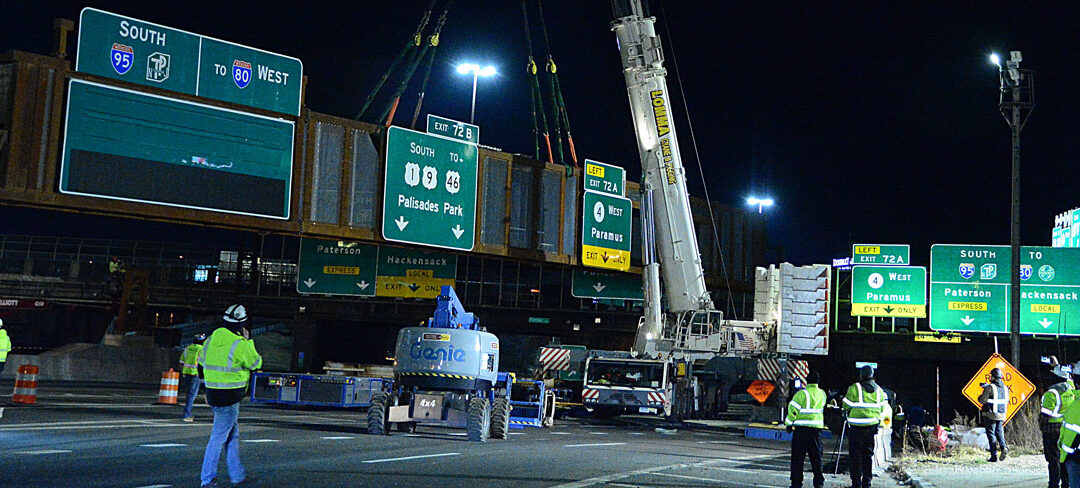Ted DeCagna was recently commissioned by a large NJ construction company to document the installation of a 14-lane wide, 174 foot wide highway traffic sign on the New Jersey Turnpike in Fort Lee, NJ just outside of the George Washington Bridge. This is the largest sign on the NJ Turnpike erected February 3rd, 2024.
This construction photography shoot job required starting at 10 pm on a Saturday night when 3 lanes of traffic could be stopped without creating a massive traffic jam back up and required shooting until 5 Am. Of course, the shooting assignment came with several major challenges. The first challenge was shooting in the rain which was not predicted but I had to get the photos given the very high expense of having a huge crew of about 28 men on the job site, a 20-ton crane, special lighting set up, 80-wheel robotic flatbed truck, numerous lifts, bulldozers, etc. Of course, it critical to keep your equipment very dry and protected. So, the simple and obvious trick to shooting in the rain is to have two large golf umbrellas clamped to two heavy light stands which I positioned over my Nikon and over my Sony video camera. I also used a protective camera leather case cover with a flop up back. I cut a hole through the camera protective case just tight enough to fit the lens through.
I always use a crystal-clear protective filter over the lens and the case back that flops up allows access to the camera dials and buttons. The golf umbrellas did a great job of keeping my cameras dry while allowing me to shoot the action with no real problems. I weight down my tripods and light stands holding the umbrellas with 2 – 5 lb. dumbbell plates that I put in a heavy plastic gym bag that’s tied firmly shut and enable you to spread the two plates at two ends of the bag and hang them from a center hook on tripod one and slide the weights in both sides of the center support on tripod two. I like the dumbbell plates much better than sand bags. Weighting down your tripod is very important for two reasons one, shooting at night requires a low ISO if you want razor sharp clarity and shooting with a low ISO of 100 or 200 means you must have a good tripod that will lock your camera into place and avoid any blur. Without a weighted tripod the slightist wind is enough to give you blur. Another smart tip to shooting at night is to use a remote control rather than hitting your shutter button as pressing the shutter button is enough to create some blur so why not avoid any risk of blur by using a $29. remote control shutter release and turning on the remote control setting on your camera. The golf umbrellas did a great job at keeping my equipment dry but I also used heavy ponchos to cover the entire camera from blowing wind when the rain got very heavy.
Another shooting tip for any night time construction photographer in New York or New Jersey is to use aperture priority mode and a low aperture setting, about 4.5 seemed to be the perfect setting to avoid noise and give me crystal clear photos.
My final tips are for shooting in freezing temperatures. First keep your camera in your trunk hours before your shoot so the camera does not get warm. Keeping a warm camera inside your heated car then going out in freezing temperatures can give you condensation on the lens and viewfinder, so keep your camera in your trunk or an ice cooler. My second tip if obviously to dress with at least 3 layers on and I use one of the electric ( battery operated) heated vest which helped a lot on a 29 degree. Finally, hand warmers ( Costco or Walmart) are great chemical pouches that can really help keep your hands and feet warm in all the hours of down time waiting for your construction crew to move into action. Standing out in 29 degree cold for 7 hours was not easy so I even duct taped two chemical heat pouches inside my hat at the exact point of my ears they worked very well to keep me comfortable.
Numb fingers or hands from extreme cold and rain are no fun but operating your camera with gloves is a real problem also. Costco also sells a Zippo USB chargeable heated hand grip for your pocket which really helps avoid the numbness of no gloves when needed to maneuver your cameras. And if you can purchase professional photographers’ gloves, do it as the finger tips for fingers and thumbs fold back to operate all the camera dials and shutter when you need them but you can still keep 95 percent of your hands very warm. So, when your client needs a New Jersey construction photographer these night time, cold weather and rain tips will help you deliver perfect photos despite very challenging conditions.


Recent Comments